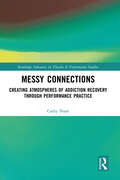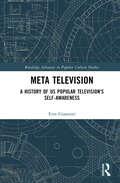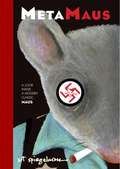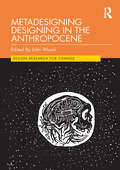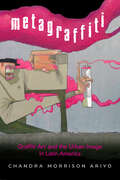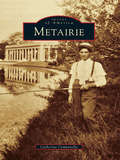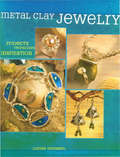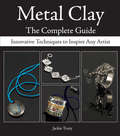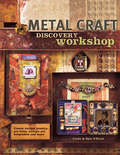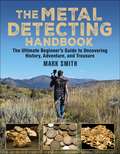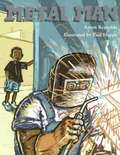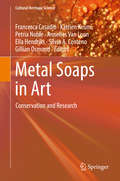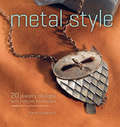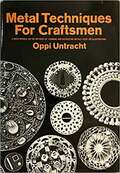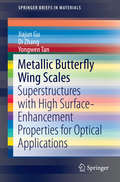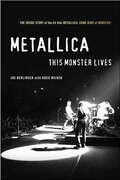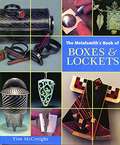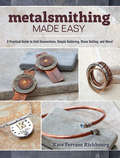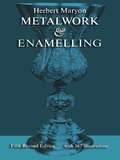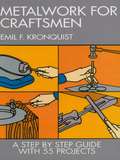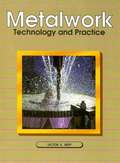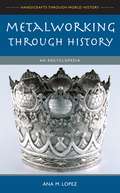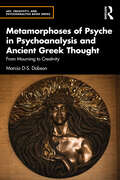- Table View
- List View
Messy Connections: Creating Atmospheres of Addiction Recovery Through Performance Practice (ISSN)
by Cathy SloanThis book examines performance practices that involve people in recovery from addiction, theorising such practices as recovery-engaged.Focusing on examples of practice from a growing movement of UK-based recovery arts practitioners and performers, it highlights a unique approach to performance that infuses an understanding of lived experiences of addiction and recovery with creative practice. It offers a philosophy of being in recovery that understands lived experience, and performance practice, as a dynamic system of interrelations with the human and nonhuman elements that make up the societal settings in which recovery communities struggle to exist. It thereby frames the process of recovery, and recovery-engaged performance, as an affective ecology – a system of messy connections. Building upon ideas from posthumanist research on addiction, cultural theory on identity and new materialist interpretations of performance practice, it considers how such contemporary theory might offer additional ways of thinking and doing arts practice with people affected by addiction. The discussion highlights the distinct aesthetics, ethics and politics of this area of performance practice.This study will be of great interest to students and scholars in Applied Theatre and Critical Arts and Mental Health studies.
Meta Television: A History of US Popular Television's Self-Awareness (Routledge Advances in Popular Culture Studies)
by Erin GianniniThe idea of metatextuality is frequently framed as a recent television development and often paired with the idea that it represents genre exhaustion. US television, however, with its early “live” performances and set-bound sitcoms, always suggested an element of self-awareness that easily shaded into metatextuality even in its earliest days. Meta Television thus traces the general history of US television’s metatextuality throughout television’s history, arguing that TV’s self-awareness is nothing new—and certainly not evidence of a period of aesthetic exhaustion—but instead is woven into both its past and present practice, elucidated through case studies featuring series from the 1970s to the present day—many of which have not been critically analyzed before—and the various ways they deploy metatext to both construct and deconstruct their narratives. Further, Meta Television asserts that this re- and de-construction of narrative and production isn’t just a reward to the savvy and/or knowledgeable viewer (or consumer), but seeks to make broader points about the media we consume—and how we consume it.This book explores the ways in which the current metatextual turn, in both the usual genres in which it appears (horror and sci-fi/fantasy) and its movement into drama and sitcom, represents the next turn in television’s inherent self-awareness. It traces this element throughout television’s history, growing from the more modest reflexivity of programs’ awareness of themselves, as created objects in a particular medium, to the more significant breaking of the fictive illusion and therefore the perceived distance between the audience and the series. Erin Giannini shows how the increased currency of metatextual television in the contemporary era can be tied to a viewership well-versed in its stories and production as well as able and willing to “talk back” via social media. If television reflects culture to a certain extent, this increased reflexivity mirrors that “responsive” audience as a consequence of the lack of distance that metafiction embraces.As Robert Stam traced the use—and implications—of reflexivity in film and literature, this book does the same for television, further problematizing John Ellis’s glance theory in terms of both production and spectatorship.
MetaMaus: A Look inside a Modern Classic, Maus
by Art SpiegelmanMETAMAUS is built around a series of taped conversations with Hillary Chute. (She is currently Neubauer Family Assistant Professor in the English Department at the University of Chicago and was previously a Junior Fellow in Literature in the Society of Fellows at Harvard University.)
Metadesigning Designing in the Anthropocene (Design Research for Change)
by John WoodLong-sighted, radical and provocative, this book offers a foundational framework of concepts, principles and methods (exemplified with selected tools) to enable metadesigners to manage and reinvent their practices. The book reminds readers that designers are, albeit unwittingly, helping to shape the Anthropocene. Despite their willingness to deliver greener products and services, designers find themselves part of an industry that has become the go-to catalyst for dividends and profit. If our species is to achieve the rehabilitation and metamorphosis, we may need to design at the level of paradigms, genres, lifestyles and currencies. This would mean making design more integrated, comprehensive, adaptive, transdisciplinary, self-reflexive and relational. The book, therefore, advocates a shift of emphasis from designing ‘sustainable’ products, services and systems towards cultivating synergies that will induce regenerative lifestyles. The book will be of interest to managers, designers, scholars and educators from a wide range of backgrounds, including design research, design history, design studies and environmental studies.
Metagraffiti: Graffiti Art and the Urban Image in Latin America
by Chandra Morrison AriyoFocusing on graffiti scenes from São Paulo and Santiago in Chile, this innovative visual ethnography examines diverse forms of self-reference and metareference that appear in Latin American graffiti art. Chandra Morrison Ariyo works across multiple scales of contemporary graffiti production—from tags to massive murals—to show how painting the city enables individuals to reimagine their own position within the material and social structures around them. Metagraffitti reveals how practitioners such as Tinho, OSGEMEOS, Grin, and Bisy use metagraffiti features to influence public perceptions about this art form and its effect on the urban environment. Ultimately, Metagraffiti proposes a novel conceptual framework that highlights graffiti’s ability to forge alternative forms of movement, sociality, and value within Latin American cityscapes. These urban images invite us to imagine what the city could be, when seen as a site for action and imagination.
Metairie (Images of America)
by Catherine CampanellaMetairie was the first suburb of New Orleans; an outgrowth to the west by young families seeking larger lots, open air, and affordable new housing. Those suburbanites shared much in common with previous generations of New Orleanians who had migrated westward from the original town (now the French Quarter) to high land along the Mississippi River and the Metairie Ridge. When Jefferson Parish was established in 1825, it included all New Orleans faubourgs west of Felicity Street--what we now know as Uptown New Orleans. These would become the first cities in Jefferson Parish: Carrolton, Jefferson, and Lafayette. By the early 1900s, the westward expansion continued into what we now call Old Metairie and Bucktown. During the mid-20th century, Metairie boomed and is now one of the largest communities in Louisiana. While many residents consider themselves New Orleanians, even those born generations after their families moved to the suburb, Metairie has its own unique history.
Metal Clay Jewelry: Projects. Techniques. Inspirations.
by Louise DuhamelExplore the endless possibilities of metal clay Sculpt it, cut it, shape it, roll it. Just about anything is possible when you're creating with the amazing medium of metal clay. Whether you're new to its wonders or are looking for new ideas and techniques, Metal Clay Jewelry has it all. Metal clay artist and instructor Louise Duhamel starts with the basics of the medium explaining the different forms of clay and teaching the basic techniques. Then the fun really begins! In twenty projects created by Louise and other talented clay artists, you'll learn more fabulous techniques including origami folding with paper clay, sculpting with paste clay, enameling, creating hollow forms and so much more. With step-by-step photography throughout, you won't miss a beat as you explore this amazing medium. In addition, with variation projects and a gallery of stellar art by world-renown artists, you get all the inspiration you'll need to start designing your own metal clay pieces. Discover all the possibilities of metal clay today!
Metal Clay The Complete Guide: Innovative Techniques to Inspire Any Artist
by Jackie TrutyExplore Metal Clay from Package to Project Metal clay's versatility and ability to be enhanced by every other known medium has broadened design possibilities for artists everywhere. Metal Clay The Complete Guideis the reference book every metal clay artist needs to have on the shelf for quick access to how-to information on a variety of subjects, including: Materials and tools for working with metal clay Metal clay care and handling, including tips for keeping your clay from drying out Techniques including rolling, adding texture, stamping, lids and forming How-tos for shaping bails, loops, beads and connectors Mixing metal clay with glass, enamels, beads, gemstones and more Tips and troubleshooting Four projects: bracelets, lentil bead, box pendant, ring Helpful appendices, including ring sizing, gemstone firing times, drying times, kiln firing temperatures and alternative firing methods Whether you are just getting started or have been working with metal clay or related materials for years,Metal Clay The Complete Guideis guaranteed to be the resource you turn to the most.
Metal Craft Discovery Workshop: Create Unique Jewelry, Art Dolls, Collage Art, Keepsakes And More!
by Opie O'Brien Linda O'BrienCreating with metal has never been easier!Whether it's jewelry, journals or kitschy keepsakes that spark your fire, Metal Craft Discovery Workshop shows just how easy it is to create 20 fun and funky projects step-by-step, from a miniature journal to an altered lunch box.A nontraditional approach and a comprehensive techniques section will introduce you to the whimsical side of metal. Not only will you learn secrets to cutting and joining metal, you'll also:Explore ways to age and add texture to metalDiscover the numerous types of metal available, including copper, mesh, wire and recycled materialConjure up beautiful patina finishes with several "secret" recipesFind further inspiration in the artists' gallery sectionYou'll love creating these pieces, whether you've worked with metal before or you're new to the medium. Give your recycle bin a second glance and start crafting beautiful pieces with metal today.
Metal Detecting: The Ultimate Beginner's Guide to Uncovering History, Adventure, and Treasure
by Mark SmithEnthusiastic, thorough, and everything you need to know about discovering buried treasure!There is an incredible amount of treasure buried right under our feet, but most people don't even know this huge amount of untold wealth exists. Imagine how it must feel to uncover large caches of silver and gold coins or long-lost jewelry packed with shimmering, precious stones. These are not some made-up fairy tales-there are people who, at this very moment, are finding these treasures.Veteran metal detector and treasure hunter Mark Smith takes you under his wing and demystifies treasure hunting in Metal Detecting by revealing his most closely guarded secrets and sharing personal stories of success. These valuable lessons and truly amazing treasure hunting stories will make you wonder why you aren't out there with a metal detector right now!Metal Detecting cuts right through the technical jargon and spells everything out with full-color illustrations and easy-to-understand terms, making this book simple to follow, regardless of your prior treasure-hunting experience. Novices and seasoned veterans will both find plenty of helpful information buried in the pages of this book-from choosing your first metal detector to finding locations loaded with unlimited treasure possibilities, and everything in between. Mark shows you how to get out there and claim your own share of treasure, be it gold, silver, meteorites, old coins, jewelry, or relics. What are you waiting for? Grab a copy today and start uncovering history, adventure, and treasure!
Metal Forming
by William F. Hosford Robert M. CaddellThis book helps the engineer understand the principles of metal forming and analyze forming problems - both the mechanics of forming processes and how the properties of metals interact with the processes. In this fourth edition, an entire chapter has been devoted to forming limit diagrams and various aspects of stamping and another on other sheet forming operations. Sheet testing is covered in a separate chapter. Coverage of sheet metal properties has been expanded. Interesting end-of-chapter notes have been added throughout, as well as references. More than 200 end-of-chapter problems are also included.
Metal Man
by Paul Hoppe Aaron Reynolds"There's a fire in me, just like that torch." Devon visits the Metal Man at his fiery workshop every day, despite the scorching heat of the city where he lives. At the Metal Man's shop, sparks fly from his welding torch as he cuts and melts together old pieces of junk into works of art. Devon is fascinated by the Metal Man's creations. Then one day, the Metal Man lets Devon put his own imagination to work. Aaron Reynolds's urban voice and the gritty illustrations of Paul Hoppe bring an exciting beat and pulse to the story of a young boy discovering his own voice and vision in art with a kind mentor to lead the way.
Metal Soaps in Art: Conservation and Research (Cultural Heritage Science)
by Francesca Casadio Katrien Keune Petria Noble Annelies Van Loon Ella Hendriks Silvia A. Centeno Gillian OsmondThis go-to reference work surveys the current state of knowledge in the field of metal soap-related degradation phenomena in art works. It contains detailed descriptions and images of the different phenomena and addresses the practical aspects of soap formation, preventive conservation, and treatment.The occurrence of metal soaps is one of the defining issues in the conservation of painted surfaces, and one that presently leaves innumerable open questions. It is estimated that around 70% of paintings in museum collections are affected by some form of metal soap-related degradation. In recent years, significant advances have been made in the detection and characterization of these compounds through interdisciplinary approaches including conventional spectroscopy and microscopy as well as emerging synchrotron-based techniques. This book for the first time captures a panoramic overview of the state of knowledge of metal soaps related to both scientific analysis and implications for conservation and treatment. It also critically examines open questions. The book is accessible to audiences with varied backgrounds (e.g. conservators, students of conservation science) while simultaneously presenting the technical details indispensable for academics and researchers active in this field.
Metal Style: 20 Jewelry Designs with Cold Join Techniques
by Karen DoughertyDiscover the possibilities of cold joins The hottest trend is cold. Cold-connection techniques are pushing the envelope of what is possible in metal without the use of a torch or kiln. All the necessary tools and materials-a common drill, hammer, sandpaper, wire, metal sheet-are all readily available and affordable for almost any budget. Learn how to use rivets, screws, and other materials to combine elements without having to deal with heat. Master jewelry designers Robert Dancik, Connie Fox, Susan Lenart Kazmer, Tracey Stanley, and others offer signature pieces, constructed using cold-joins. Accompanying each project are expert tips and tricks for additional ideas and customization. Metal Styleis full of inspiration and techniques for jewelry makers looking to ignite a creative spark in their metal jewelry without lighting a flame.
Metal Techniques For Craftsmen: A Basic Manual For Crastmen On The Methods Of Forming And Decorating Metals
by Oppi UntrachtAn illustrated guide offers step-by-step instructions in forming, fabricating, and finishing metal objects
Metallic Butterfly Wing Scales
by Jiajun Gu Di Zhang Yongwen TanThis book presents a method for replicating natural butterfly wing scales using a variety of metals for state-of-the-art applications requiring high surface-enhancement properties. During the past decade, three dimensional (3D) sub-micrometer structures have attracted considerable attention for optical applications. These 3D subwavelength metallic structures are, however, difficult to prepare. By contrast, the 3D superstructures of butterfly wing scales, with more than 175 000 morphologies, are efficiently engineered by nature. Natural butterfly wing scales feature 3D sub-micrometer structures that are superior to many human designs in terms of structural complexity, reproducibility, and cost. Such natural wealth offers a versatile chemical route via the replication of these structures into functional metals. A single versatile chemical route can be used to produce butterfly scales in seven different metals. These synthesized structures have the potential for catalytic (Au, Pt, Pd), thermal (Ag, Au, Cu), electrical (Au, Cu, Ag), magnetic (Co, Ni), and optical (Au, Ag, Cu) applications. Plasmon-active Au, Cu, Ag butterfly scales have exhibited excellent properties in surface-enhanced Raman scattering (SERS). The Au scales as SERS substrates have ten times the analyte detection sensitivity and are one-tenth the cost of their human-designed commercial counterparts (KlariteTM). Preliminary mechanisms of these surface-enhancement phenomena are also reviewed.
Metallica: This Monster Lives
by Greg Milner Joe Berlinger“Triumphs because of the commitment and fearlessness of Metallica . . . [and] shows that tenacious reporting can still produce great narratives.” —New York TimesMetallica is one of the most successful hard-rock bands of all time, having sold more than ninety million albums worldwide. Receiving unfettered access, acclaimed filmmakers Joe Berlinger and Bruce Sinofsky followed Metallica over two and a half years as they faced personal and professional challenges that threatened to destroy the band just as they returned to the studio to record their first album in four years. While the documentary itself provides an insider’s view of Metallica, the two and a half years of production (and more than 1,600 hours of footage) garnered far more than can be expressed in a two-hour film.Berlinger’s book reveals the stories behind the film, capturing the uncertainty, and ultimate triumph of both the filming and Metallica’s bid for survival. It weaves the on-screen stories together with what happened off-screen, offering intimate details of the band’s struggle amidst personnel changes, addiction, and controversy. In part because Berlinger was one of the only witnesses to the intensive group-therapy sessions and numerous band meetings, his account is the most honest and deeply probing book about Metallica—or any rock band—ever written.“A fascinating look at the logistics of making an album and the dysfunctional family that bands can become.” —Chicago Tribune“This book should be required reading for aspiring filmmakers.” —Publishers Weekly“Berlinger takes us even deeper into the inner sanctum. . . . many events that were edited for the film, including a pivotal scene in which drummer Lars Ulrich laces into singer James Hetfield, are transcribed in full.” —USA Today
Metalsmith's Book of Boxes & Lockets
by Tim McCreightThis book, published in a print edition in 1999 has been praised for its high quality photos and practical information. In addition to featuring scores of exciting boxes by contemporary designers from around the world, the book describes dozens of hinges, catches and construction techniques in practical detail. Intended for intermediate metalsmiths, this book will not only teach you how to make that special hinge, but get you excited about what to do with it.
Metalsmithing Made Easy: A Practical Guide to Cold Connections, Simple Soldering, Stone Setting, and More!
by Kate RichbourgFollowing the success of her first book, Simple Soldering, Kate Ferrant Richbourg walks kitchen table metalsmiths through the basics and into new territory! In addition to teaching the essentials of soldering, Metalsmithing Made Easy demystifies rotary tools and introduces different kinds of hotter small-space torches. In her signature friendly, easy-to-follow style, Kate lays out a lesson plan of techniques to help readers gain familiarity with soldering tools and methods. In the chapter "The Field Guide to the Rotary Tool" you will learn how to quickly and efficiently, with a simple handheld tool and a few select bits, add professional-quality surface effects and finishing to your jewelry designs. A practice sampler of metal tiles, to be worked on step by step, helps to hone skills in surface manipulation, stone setting, cold connections, and more. Once these skills are mastered in the sampler, you can undertake any (or all) of fifteen gorgeous projects included, such as a locket, bail with set stone, prong-set pendant, and much more.
Metalwork (Merit Badge Series)
by Boy Scouts of AmericaThis booklet introduces a scout to the world of working with metals. It also teaches the history of metal work. It includes instruction on the use and collection of metal working tools.
Metalwork and Enamelling
by Herbert MaryonAll those concerned with goldsmithing, silversmithing, rare metal objects, or metal scientific instruments, or their repair or restoration will be delighted to find this bible of their craft available again in a new edition. And those interested in such work as one of the most rewarding of all avocational arts can hardly find a better guide. For this is the professional's handbook -- the standard text on the subject.The author, who, among his other achievements, was responsible for reconstruction work on the Sutton Hoo treasure in the British Museum (and was awarded the Order of the British Empire for his work), treats every aspect of the craft in detail, from basic tools to casting and enameling in separate sections. After discussing materials and tools, he provides a treatment of soldering in rare metals that is more extensive, more thorough, and richer in practical advice than can be found elsewhere. He continues into filigree work, the setting of stones, raising and shaping, spinning, repoussé work, wire twisting, hinges and joints, inlaying and overlaying, niello, alloys and stratified fabrics, enameling (including cloisonné, plique-à-jour, champlevé, bassetaille, encrusted and painted enamels), metal casting, construction, setting out, polishing and coloring, design, and assaying and hallmarking. Wherever possible, he analyzes examples of fine craftsmanship, ancient and modern, to illustrate practical aspects of the process he is explaining. Helpful hints are included on shop set-up and safety. The vastness of the author's experience in the actual work, with his authoritative knowledge of the entire field, ensures that readers of Metalwork and Enamelling are being advised and guided by a renowned expert.Over 300 figures and photographs amplify the discussion of tools, materials, and construction. Tables and standards useful to the craftsman (melting points and weights of metals, for example) are included. Notes to the photographic plates describe the objects in detail -- magnificent examples of craftsmanship throughout the ages. Both complete and concise, this book belongs close to every rare metals workshop, laboratory, museum shop, and craft center.
Metalwork for Craftsmen
by Emil F. KronquistThis book, by a master craftsman who has devoted much of his life to teaching, is an exceptionally useful handbook in the techniques of sheet metalcraft. Presenting easy-to-follow and complete instructions on pages opposite to carefully executed drawings and diagrams, he makes it possible for anyone to learn the basics of this art form and to fashion objects which are at once beautiful and useful, and which display the individual expressiveness of the maker.Beginning with fundamentals, the author lists and pictures all of the necessary tools and carefully explains basic techniques for cutting stock, annealing and heating, pickling, shallow hollowing, raising, planishing, bending and shaping, leveling, soldering and welding, making molds, pattern making, and all of the steps and processes in the fine art of chasing. There follows a series of specific projects for making candlesticks, coasters, fluted platters and bowls, beakers, pitchers, serving trays, lamps, and a host of other articles in a wide variety of designs. A selection of thumbnail sketches for further exploration is included, and complete instructions are given for finishing and oxidation.The compact and graphic method of presentation makes this an extremely handy book, and the projects contained in it will engage the accomplished craftsman as well as the amateur. The approach is consistently from the craftworker's point of view, and the description of workshop methods are clear and direct and result from the author's lifelong experience in actual work and in instruction.
Metalwork: Technology and Practice (9th edition)
by Victor E. ReppThis book provides a comprehensive introduction to metal fabrication technology. It is intended as a textbook for entry level courses that provide laboratory experiences in metal fabrication.
Metalworking Through History: An Encyclopedia
by Ana M. LopezLopez, a metalsmith and educator, has compiled an encyclopedia that focuses on the processes, people, places, cultures, and materials of metalworking. While this reference does not provide instructions for metalworking techniques, it does give the reader enough information to appreciate the skills required to both acquire the raw materials and to transform them into useful or symbolic objects of art. Entries are followed by suggestions for further reading which may include books, Web sites, and journals. Entries also include bibliographies. A helpful timeline also is included. Annotation ©2009 Book News, Inc., Portland, OR (booknews.com)
Metamorphoses of Psyche in Psychoanalysis and Ancient Greek Thought: From Mourning to Creativity (Art, Creativity, and Psychoanalysis Book Series)
by Marcia D-S. DobsonThis unusual book explores the transformative power of liminal experiences in ancient Greek texts, psychoanalytic theory, and the author’s own life, to demonstrate how a contemporary understanding of ancient thought can illuminate modern psychoanalytic theory and practice especially as it relates to trauma, grief, and the development of psyche. With the understanding that liminal experiencing involves engaging a psychic space outside the boundaries of ego organization, Dobson artfully interweaves autobiography, literary analysis, philosophical ontology, and psychoanalysis, to formulate a new paradigm for how to construct human beings, how to enliven and deepen personal and therapeutic experience, and how poetic language is the gateway to this magical realm of transformation. Alongside richly detailed case analyses, the author uses her dual expertise in psychoanalysis and ancient Greek literature to explore how the maternal and liminal in human life were displaced with the rise of Athens and a new way of being human — the rational citizen — and how this repression has resulted in diminished, constricted experiencing and the suppression of women throughout western history. With a deep understanding of classical literature and psychoanalysis, and extensive clinical insights, this is essential reading for psychoanalysts, psychotherapists, classicists, and historians wishing to understand how ancient thought and modern psychoanalysis can interact.
